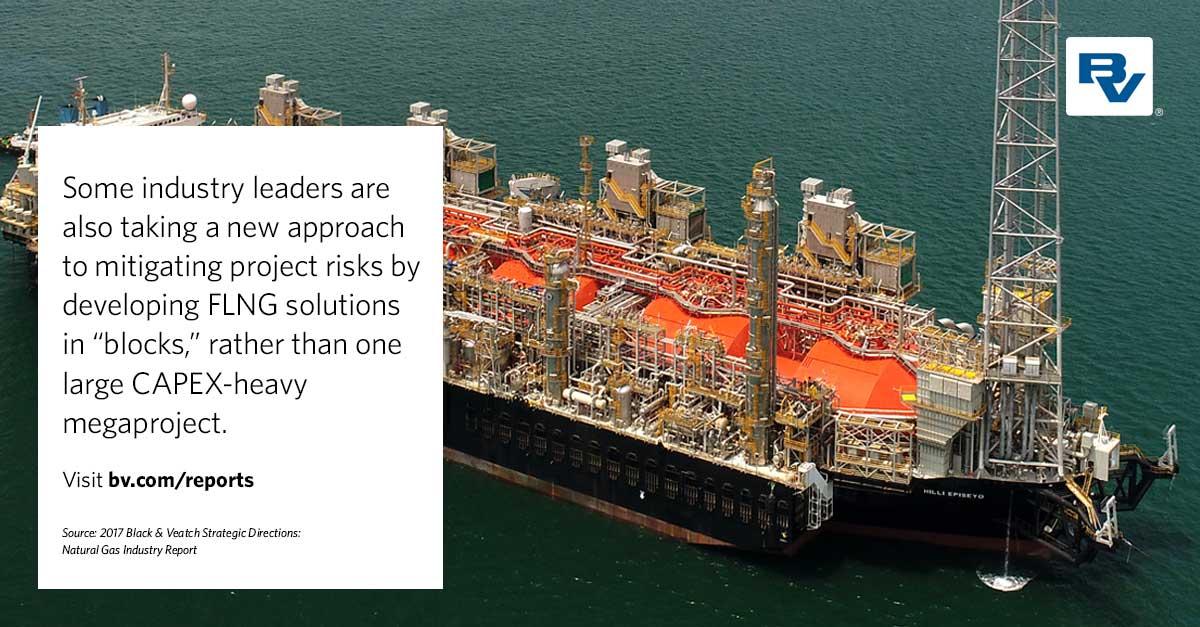For FLNG Projects, Bigger Is Not Always Better

For FLNG Projects, Bigger Is Not Always Better
Floating liquefied natural gas (FLNG) projects, after years of planning and development, are finally starting to come online and demonstrate the potential for FLNG technology to further global gas trade. LNG liquefaction was named the second most critical infrastructure investment for growth in the natural gas market, according to survey results from the 2017 Strategic Directions: Natural Gas Industry Report, and floating solutions provide a more flexible solution to adding much needed capacity to boost market growth.
Download the 2017 Natural Gas Industry Report
The ability to sell offtake gas through floating solutions has attracted the attention of producers and investors alike. Floating applications typically require fewer resources than onshore facilities and have the added capability of being able to be transported to nearly any location. Current market trends point to smaller-scale projects being more profitable in the long-term, but regardless of size, developing a sustainable business model will involve overcoming financing hurdles.
Commercial Viability Key to Investment Decisions
As with any critical infrastructure project, investments will rely on market dynamics that incentivize project development. In this year’s report, low natural gas prices and the ability to build gas infrastructure to serve demand growth were named the top factors that will impact natural gas growth, reflecting the need to create solutions that respond to those dynamics.
FLNG projects can more quickly move supply to end users versus a traditional onshore facility, which is particularly crucial in the current price environment. With these forces at work, it is not surprising that commercial viability was named the top driver for making FLNG investment decisions, followed by implementation costs and global LNG market trends. These drivers further suggest that cost and speed of delivery are top priorities for investors.
To make projects more commercially viable, developers are partnering with engineering, construction and technology providers that can configure FLNG solutions that assure returns. Black & Veatch’s patented PRICO® process, for instance, can liquefy natural gas easier, faster and more cost-efficiently than traditional technologies. PRICO® has been applied to the Exmar Caribbean FLNG project, which successfully completed performance testing in November 2016. Exmar is currently discussing several deployment opportunities for the supply from this project.
FLNG Projects Evolve with Market
Initial FLNG developments focused on building massive facilities that could move and process large quantities of LNG (5 million tons per annum (mtpa) and up), requiring significant capital investments in the vicinity of $10 billion or more. These commitments could only be afforded by a few independent oil companies and national oil companies who were willing to take on risks associated with still fairly nascent FLNG concepts. The capital expenditure (CAPEX) dollar per ton of production was extremely high at more than $3 billion/mtpa, however, LNG prices were higher a few years ago which made the model seem more economically sound at the time.
Global LNG prices have since dropped considerably, and developers are taking lessons learned from projects that have been recently commissioned. As such, FLNG project planning is evolving to meet these market conditions, and smaller-scale models are gaining traction. Survey respondents also believe these projects will be the most lucrative - nearly a third (29 percent) believe that the LNG production “sweet spot” most dominant in the market will be between 3 to 4 mtpa.
The new project model typically involves the development of a small to midscale liquefaction facility moored in protected waters, or to a jetty where gas is processed at a nearby offshore field or liquefied from an existing pipeline onshore. These simpler nearshore FLNG configurations can be deployed with shorter schedules than the industry’s initial FLNG initiatives.
Phased Approach Gains Traction
Some industry leaders are also taking a new approach to mitigating project risks by developing FLNG solutions in “blocks,” rather than one large CAPEX-heavy megaproject. The phased approach allows developers to build out projects in stages. Instead of taking on a 12 mtpa project, they could start with a 3 mtpa block, generate some revenue, and then construct subsequent phases incrementally thereafter. This approach also makes the solution easier to manage and finance, allows variable sales commitment volumes, and does not force producers to lock in offtakers taking in large LNG volumes before a train could start producing.
Ophir Energy, for example, is awarding contracts for projects phase-by-phase, in case they need to disconnect supply from any of their three vessels. In May 2017, the organization awarded the midstream construction contract for the Fortuna FLNG project which will channel gas from their offshore “block R” development.
Planning for Future Demand
While FLNG solutions continue to advance, the expectation from the industry is that the need for these projects is not expected to abate anytime soon. When asked if the trend to monetize stranded gas reserves with low condensate levels will continue to gain interest given sustained periods of low gas prices, more than a third of respondents (38 percent) agreed that was their expectation.
With sustained low prices and thin margins, FLNG project developers will continue to innovate to stay competitive. For now, the industry is discovering that bigger is not always better, and smaller or mid-size solutions are likely to provide a better return on investment.
The challenging market also demands a new level of flexibility. This includes flexibility in terms of size, with modular facilities that can scale to meet changing production targets. New business models will also continue to drive collaboration as new partnerships, joint ventures and consortiums bring more FLNG projects to life. Flexibility in financing will influence how contracts are structured and enable industry players of all sizes with a comprehensive strategy to be poised to have a competitive edge in the market.

